-
 Bitcoin
Bitcoin $106,754.6083
1.33% -
 Ethereum
Ethereum $2,625.8249
3.80% -
 Tether USDt
Tether USDt $1.0001
-0.03% -
 XRP
XRP $2.1891
1.67% -
 BNB
BNB $654.5220
0.66% -
 Solana
Solana $156.9428
7.28% -
 USDC
USDC $0.9998
0.00% -
 Dogecoin
Dogecoin $0.1780
1.14% -
 TRON
TRON $0.2706
-0.16% -
 Cardano
Cardano $0.6470
2.77% -
 Hyperliquid
Hyperliquid $44.6467
10.24% -
 Sui
Sui $3.1128
3.86% -
 Bitcoin Cash
Bitcoin Cash $455.7646
3.00% -
 Chainlink
Chainlink $13.6858
4.08% -
 UNUS SED LEO
UNUS SED LEO $9.2682
0.21% -
 Avalanche
Avalanche $19.7433
3.79% -
 Stellar
Stellar $0.2616
1.64% -
 Toncoin
Toncoin $3.0222
2.19% -
 Shiba Inu
Shiba Inu $0.0...01220
1.49% -
 Hedera
Hedera $0.1580
2.75% -
 Litecoin
Litecoin $87.4964
2.29% -
 Polkadot
Polkadot $3.8958
3.05% -
 Ethena USDe
Ethena USDe $1.0000
-0.04% -
 Monero
Monero $317.2263
0.26% -
 Bitget Token
Bitget Token $4.5985
1.68% -
 Dai
Dai $0.9999
0.00% -
 Pepe
Pepe $0.0...01140
2.44% -
 Uniswap
Uniswap $7.6065
5.29% -
 Pi
Pi $0.6042
-2.00% -
 Aave
Aave $289.6343
6.02%
What does it mean that the trading volume continues to be lower than the 20-day average volume line?
A consistent drop in trading volume below the 20-day average may signal market indecision, consolidation, or a potential trend reversal in cryptocurrency.
Jun 18, 2025 at 05:28 am
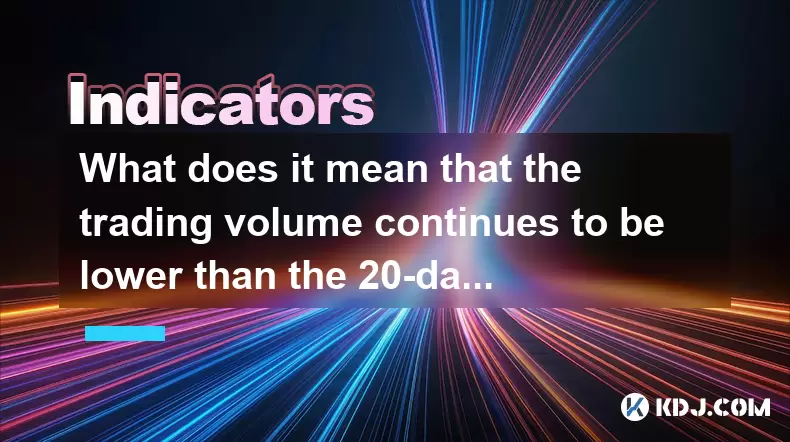
Understanding the 20-Day Average Volume Line
The 20-day average volume line is a commonly used technical indicator in cryptocurrency trading. It calculates the average daily trading volume over the past 20 days and plots it on a chart to help traders identify trends in market participation. When this metric is compared with current trading volumes, it provides insights into whether the asset is experiencing high or low interest from traders and investors.
In the context of cryptocurrency markets, where volatility is often pronounced, understanding the implications of volume trends is crucial. A consistent decline below the 20-day average volume line can signal underlying shifts in market sentiment and activity levels.
Trading volume serves as a proxy for market conviction—higher volumes typically indicate stronger price moves, while lower volumes suggest hesitation or disinterest.
Interpreting Lower Trading Volume Relative to the 20-Day Average
When the current trading volume remains consistently below the 20-day average, it suggests that fewer participants are actively buying or selling the asset. This could mean that the market lacks strong directional momentum. In many cases, this is seen as a sign of consolidation or a potential reversal, depending on the broader context of price action.
This phenomenon doesn't necessarily imply an immediate sell-off or rally but rather indicates that the market may be entering a phase of indecision or reduced interest. Traders should look at other indicators such as moving averages, RSI (Relative Strength Index), and price patterns to get a more comprehensive view.
- Consolidation Phase: Lower volume may reflect a period where prices are range-bound and not showing clear direction.
- Lack of Interest: If no major news or developments are occurring, traders might be waiting on the sidelines.
- Potential Reversal Signal: In some scenarios, especially after prolonged uptrends or downtrends, declining volume can precede a trend reversal.
How to Identify This Pattern on Charts
Identifying when trading volume drops below the 20-day average requires access to a charting platform that supports volume overlays. Most platforms like TradingView or Binance’s native tools allow users to add the volume indicator and its moving average.
To visualize this pattern:
- Open a chart: Select your preferred cryptocurrency pair (e.g., BTC/USDT).
- Add the volume indicator: Look for “Volume” under indicators and apply it to the chart.
- Overlay the 20-day moving average: Customize the volume settings to show a 20-period simple moving average (SMA) of volume.
- Compare visually: Observe how current volume bars compare to the SMA line—when they remain consistently beneath it, the condition is met.
This visual comparison allows traders to make real-time decisions based on volume behavior without relying solely on price movements.
Possible Causes Behind Declining Volume
Several factors can contribute to a scenario where trading volume falls below the 20-day average:
- Market Fatigue: After a significant price movement, traders may take profits and wait for the next opportunity, leading to reduced activity.
- Absence of News: Cryptocurrency markets are highly sensitive to news events. Without new catalysts, interest can wane.
- Seasonality: Certain times of the year, such as holidays or summer months, may naturally experience lower trading activity.
- Regulatory Uncertainty: Periods of regulatory speculation or announcements can cause traders to hold off on making large moves.
Each of these factors influences trader psychology and behavior, which in turn affects the volume seen on exchanges.
Strategic Implications for Traders and Investors
For active traders, a persistent drop in volume relative to the 20-day average can serve as a cautionary signal. It may prompt them to reduce exposure or tighten stop-loss orders if they suspect a potential reversal or continuation of sideways movement.
For long-term investors, this might not carry the same weight unless accompanied by deteriorating fundamentals or macroeconomic conditions affecting the crypto space broadly.
- Short-Term Traders: May consider reducing leverage or exiting partial positions during low-volume periods to avoid slippage or false breakouts.
- Swing Traders: Could use this as a confirmation tool alongside other technical signals before entering trades.
- Long-Term Holders: Might ignore short-term volume fluctuations unless there's a fundamental shift in the project or ecosystem.
It's essential to understand that volume alone isn’t a standalone signal but works best in conjunction with other forms of analysis.
Frequently Asked Questions
Q: Does lower than average volume always indicate a bearish trend?
A: No, it doesn’t automatically indicate a bearish trend. Lower volume can also signify consolidation or a pause in a bullish trend. Context is key—volume should be interpreted alongside price action and other indicators.
Q: Can I rely solely on volume to make trading decisions?
A: Volume is a powerful tool, but it should never be used in isolation. Combining it with price patterns, support/resistance levels, and momentum indicators provides a more reliable framework for decision-making.
Q: Is the 20-day average volume line suitable for all timeframes?
A: While it’s commonly applied on daily charts, traders can adjust the period to suit different timeframes. For example, intraday traders might use a 20-hour or 20-minute average depending on their strategy.
Q: How does volume behave during pump and dump schemes?
A: Pump and dump schemes often exhibit sudden spikes in volume followed by sharp declines. These artificial surges can temporarily push volume well above the 20-day average, only to fall drastically afterward as the scheme collapses.
Disclaimer:info@kdj.com
The information provided is not trading advice. kdj.com does not assume any responsibility for any investments made based on the information provided in this article. Cryptocurrencies are highly volatile and it is highly recommended that you invest with caution after thorough research!
If you believe that the content used on this website infringes your copyright, please contact us immediately (info@kdj.com) and we will delete it promptly.
- Cardano, Dogecoin, and the Altcoin Shift: What's Next?
- 2025-06-20 22:45:12
- Gold Coin, Rare, Horses: A Numismatic Roundup
- 2025-06-20 22:45:13
- Dogecoin, Shiba Inu, and the Meme Coin Mania: What's Next?
- 2025-06-20 22:25:12
- GateToken (GT) Price Prediction: Navigating 2025-2030 with a New Yorker's Sass
- 2025-06-20 23:05:13
- Pepe, Price Prediction, and Elon Musk: A NYC Take on the Frog Coin Frenzy
- 2025-06-20 23:05:13
- Core Scientific (CORZ): Needham's Price Target and the Bitcoin Mining Upside
- 2025-06-20 22:25:12
Related knowledge

Does the sudden contraction of ATR indicate the end of the trend?
Jun 20,2025 at 11:14pm
Understanding ATR and Its Role in Technical AnalysisThe Average True Range (ATR) is a technical indicator used to measure market volatility. Developed by J. Welles Wilder, ATR calculates the average range of price movement over a specified period, typically 14 periods. It does not indicate direction—only volatility. Traders use ATR to gauge how much an ...

Is the golden cross of the ROC indicator below the zero axis effective?
Jun 20,2025 at 09:42pm
Understanding the ROC Indicator and Its Role in Cryptocurrency TradingThe Rate of Change (ROC) indicator is a momentum oscillator widely used by traders to assess the speed at which cryptocurrency prices are changing. It measures the percentage difference between the current price and the price from a certain number of periods ago. The ROC helps identif...
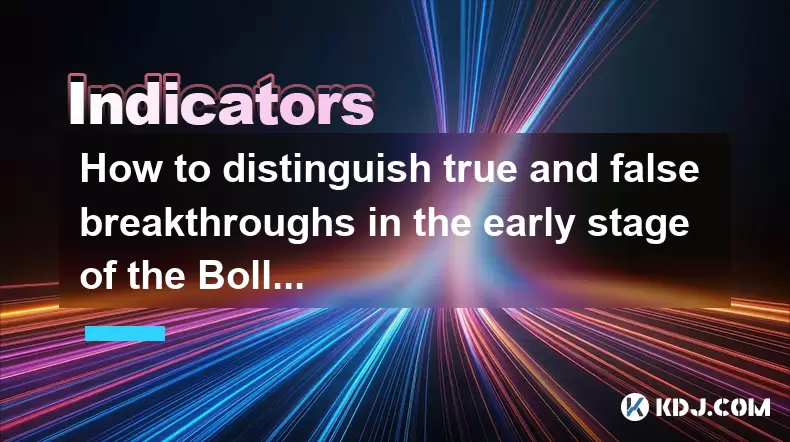
How to distinguish true and false breakthroughs in the early stage of the Bollinger Band opening?
Jun 20,2025 at 10:35pm
Understanding the Bollinger Band StructureBollinger Bands consist of three lines: a simple moving average (SMA) in the middle, and two outer bands that are standard deviations away from the SMA. These bands expand and contract based on market volatility. When the bands begin to widen, it often signals an increase in price volatility, which traders inter...
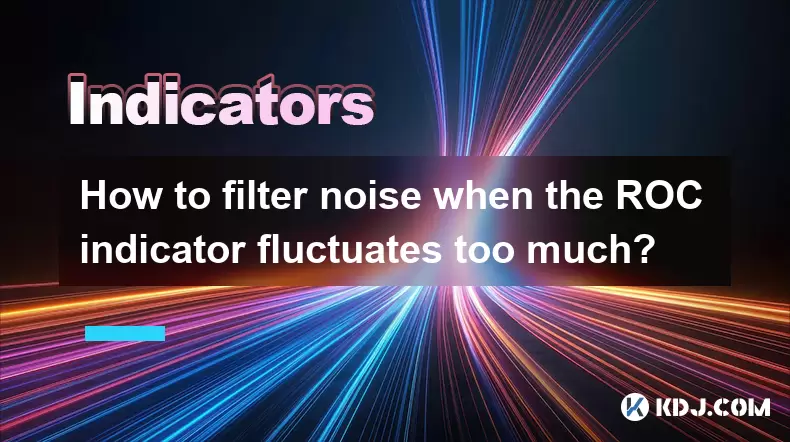
How to filter noise when the ROC indicator fluctuates too much?
Jun 20,2025 at 11:07pm
Understanding the ROC Indicator and Its SensitivityThe Rate of Change (ROC) indicator is a momentum oscillator that measures the percentage change in price between the current closing price and the closing price from a specified number of periods ago. When the ROC indicator fluctuates too much, it can create misleading signals, especially in volatile or...
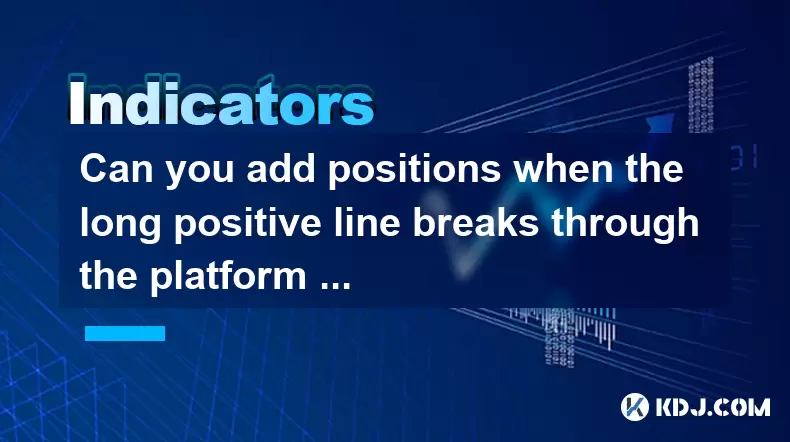
Can you add positions when the long positive line breaks through the platform and then shrinks and falls back?
Jun 20,2025 at 08:57pm
Understanding the Price Pattern: Breakthrough, Retract, and ConsolidationIn cryptocurrency trading, one of the commonly observed patterns involves a long positive line breaking through a consolidation platform, followed by a retraction or pullback. This scenario often raises questions among traders about whether to add positions after such a move. The p...
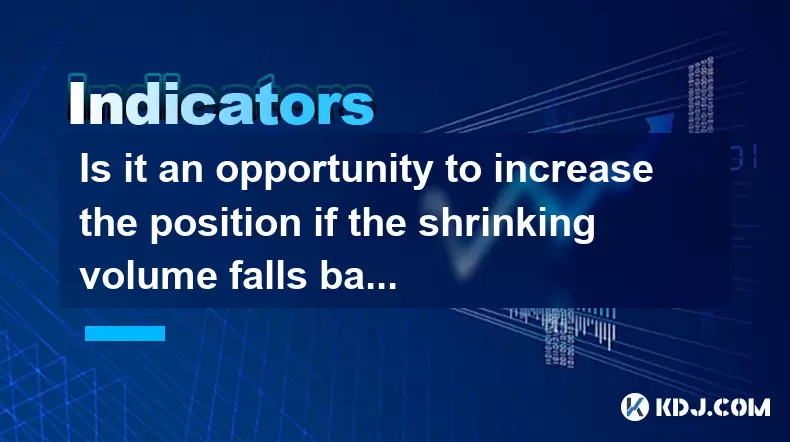
Is it an opportunity to increase the position if the shrinking volume falls back to the rising trend line?
Jun 20,2025 at 06:22pm
Understanding the Shrinking Volume in Cryptocurrency TradingIn cryptocurrency trading, volume is one of the most critical indicators used to confirm price movements and trends. When traders observe a scenario where volume shrinks during a pullback, it can signal either a lack of selling pressure or an imminent reversal. This phenomenon often occurs when...

Does the sudden contraction of ATR indicate the end of the trend?
Jun 20,2025 at 11:14pm
Understanding ATR and Its Role in Technical AnalysisThe Average True Range (ATR) is a technical indicator used to measure market volatility. Developed by J. Welles Wilder, ATR calculates the average range of price movement over a specified period, typically 14 periods. It does not indicate direction—only volatility. Traders use ATR to gauge how much an ...

Is the golden cross of the ROC indicator below the zero axis effective?
Jun 20,2025 at 09:42pm
Understanding the ROC Indicator and Its Role in Cryptocurrency TradingThe Rate of Change (ROC) indicator is a momentum oscillator widely used by traders to assess the speed at which cryptocurrency prices are changing. It measures the percentage difference between the current price and the price from a certain number of periods ago. The ROC helps identif...

How to distinguish true and false breakthroughs in the early stage of the Bollinger Band opening?
Jun 20,2025 at 10:35pm
Understanding the Bollinger Band StructureBollinger Bands consist of three lines: a simple moving average (SMA) in the middle, and two outer bands that are standard deviations away from the SMA. These bands expand and contract based on market volatility. When the bands begin to widen, it often signals an increase in price volatility, which traders inter...

How to filter noise when the ROC indicator fluctuates too much?
Jun 20,2025 at 11:07pm
Understanding the ROC Indicator and Its SensitivityThe Rate of Change (ROC) indicator is a momentum oscillator that measures the percentage change in price between the current closing price and the closing price from a specified number of periods ago. When the ROC indicator fluctuates too much, it can create misleading signals, especially in volatile or...

Can you add positions when the long positive line breaks through the platform and then shrinks and falls back?
Jun 20,2025 at 08:57pm
Understanding the Price Pattern: Breakthrough, Retract, and ConsolidationIn cryptocurrency trading, one of the commonly observed patterns involves a long positive line breaking through a consolidation platform, followed by a retraction or pullback. This scenario often raises questions among traders about whether to add positions after such a move. The p...

Is it an opportunity to increase the position if the shrinking volume falls back to the rising trend line?
Jun 20,2025 at 06:22pm
Understanding the Shrinking Volume in Cryptocurrency TradingIn cryptocurrency trading, volume is one of the most critical indicators used to confirm price movements and trends. When traders observe a scenario where volume shrinks during a pullback, it can signal either a lack of selling pressure or an imminent reversal. This phenomenon often occurs when...
See all articles

























































































